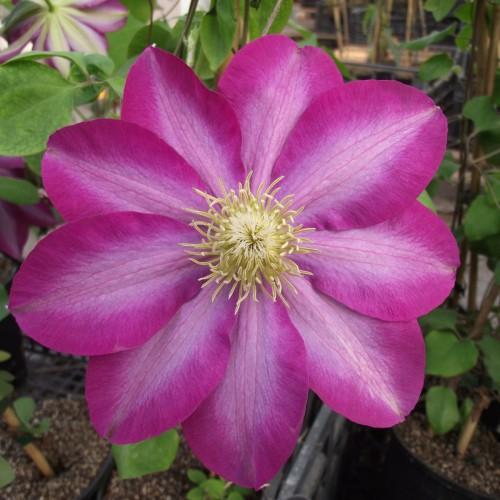
clematis
Clematis 'Evipo018' BOURBON
Cycle:
Perennial
Watering:
Average
Hardiness Zone:
4 - 8
Flowers:
Flowers
Sun:
Full sun,part shade
Leaf:
Yes
Growth Rate:
High
Maintenance:
Low
Care Level:
Medium
watering
The clematis (Clematis 'Evipo018' BOURBON) plant should be watered frequently but not over watered. During the first year of growth, the plant should be watered deeply at least once a week in order to keep the soil evenly moist. Once established, it is usually sufficient to water the plant deeply every 10 days, depending on weather conditions (i.e. higher temperatures or more wind and sun requires additional water). To determine when to water, use a finger to check the soil to a depth of 4 inches. If the soil is dry, water deeply. If in doubt, it is better to water more than less. It's also important to water early in the day as plants should not be allowed to dry out during the heat of the day.
sunlight
Clematis ‘Evipo018’ BOURBON thrives in full sunlight. This variety of Clematis should receive at least 6 hours of direct sunlight during the day, preferably morning or early afternoon sunlight. A spot that is slightly shaded in the late afternoon or early evening can help this plant from becoming too dry and stressed from the heat of the day. During the winter months, when the sun is lower in the sky, less sunlight will need to be provided.
pruning
When it comes to pruning Clematis 'Evipo018' BOURBON, the amount and timing of pruning depend upon the pruning group to which it is classified. Pruning Group 3 clematis should be pruned annually, in late winter or early spring (February to April). This is done by cutting the stems of the plant back to a height of 30-45 cm (12-18 inches) above the ground level. This encourages healthy, vigorous growth each year and helps to keep the plant within its allotted space. It also removes any dead or diseased stems, allowing healthier stems to replace them and increasing blooming for the season. Regular pruning will also help to keep the plant a manageable size and shape.
Season
Hardiness Map
FAQ
Can Clematis plants grow in pots?
Yes, Clematis plants can definitely be grown in pots. When planting a Clematis in a pot make sure to use a larger size pot with drainage holes and fill it with a mix of well-draining potting soil and compost. Ensure to keep the root area cool and the pot in a sunny location while providing regular water and fertilization. Check the plant almost daily to make sure it is not becoming too dry. Clematis can do well in a pot and with the right care and conditions, they will thrive.
Are Clematis plants self-pollinating?
No, clematis plants are not self-pollinating. Clematis plants need pollinators such as bees, butterflies, moths and other insects to transfer pollen from the male anthers to the female stigma of the flower in order to produce viable seed. Pollination must also occur within relatively close proximity of the same species in order to create viable hybrid plants.
Can Clematis plants be grown as a houseplant?
Yes, Clematis plants can be grown as a houseplant. It is best to grow them in a pot with full sun and a soil that is rich in organic material and retains moisture. When potting the plant, place a stake or trellis next to the pot so that the vine can climb when it begins to grow. Be sure to water your Clematis plant regularly to keep it healthy and growing. Additionally, keep an eye out for pests and treat with natural insecticides as necessary.
Could Clematis plants survive in a colder climate?
Yes, Clematis plants can survive in colder climates with proper preparation. If planted in the fall, proper mulching should be done to protect the roots from cold temperatures. If planted in the spring, they should be watered frequently to help them adjust to the cooler temperatures more quickly. If temperatures drop below -20°C ( -4°F), additional measures may need to be taken such as the application of protective wraps and thermal insulation. Additionally, plants in exposed areas should be protected from the wind to prevent excessive dehydration. With the right measures in place, Clematis plants can easily survive in colder climates.
Could Clematis plants be grown in a greenhouse?
Yes, clematis plants can be grown in a greenhouse. Due to their vine-like growth habit and tropical native origins, clematis plants thrive in the moist and warm environment of a greenhouse. Clematis are generally grown from cuttings or from dividing existing plants, and benefit from regular pruning and fertilizing. They will also enjoy the indirect light of a greenhouse and the protection from strong winds and temperatures that the humidity and contained environment provides.
